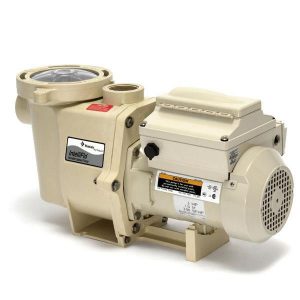 A pool can be a fantastic feature to have in your yard. It can be the source of endless fun and a place where priceless memories are made. To keep your pool fun and safe, you need to maintain it properly. An inground pool pump plays an essential role in pool maintenance. It’s what circulates the water throughout your pool so it can be filtered and sanitized. While newer pump motors are designed to be more efficient and last longer, they eventually wear out. At some point, you’ll inevitably need to replace your pool pump01 motor.
A pool can be a fantastic feature to have in your yard. It can be the source of endless fun and a place where priceless memories are made. To keep your pool fun and safe, you need to maintain it properly. An inground pool pump plays an essential role in pool maintenance. It’s what circulates the water throughout your pool so it can be filtered and sanitized. While newer pump motors are designed to be more efficient and last longer, they eventually wear out. At some point, you’ll inevitably need to replace your pool pump01 motor.
How to Tell If You Need to Replace the Motor
Not all problems with your pump are caused by the motor. If you’re going to fix a problem with your motor, you need to know what you’re trying to fix. First, make sure it’s a problem with the motor and not something that will require you to replace the entire pump. Here are some indicators that you need to replace your pool pump motor. listen for strange sounds, malfunctioning motors can make screeching, grinding, humming, or popping and clicking noises, each of which indicate problems. If it’s dead, it won’t make any sound at all. Age can be another indicator. Pool pump motors tend to last about 7-12 years.
Finding the Right Motor
Once you’ve identified the need to replace the motor, the next step is to find the right one. You can’t just pick any motor and expect it to work with your pump. Start by finding the manufacturer and model of your motor. You’ll also need to know specific information about your motor. Write down the model number, horsepower (HP), service factor (SF), RPMs, frame type (FR), voltage, and amps. You’ll need this information to pick out a new motor that will provide the right amount of power to operate the pump for your pool.
Removing the Old Pump Motor
WARNING: Working with electrical components can be extremely dangerous! We strongly advise that you contact us at Ever-Care Pool and Spa to remove and replace your pump motor rather than attempting a removal yourself.
First of all, you need to check to make sure you are getting proper voltage going to the motor. Once you’ve confirmed the voltage, it’s time to dig in and start removing the old motor. First, turn the power to the pump off at the circuit breaker to make it’s safe. Disconnect the bonding wire from the bonding lug. Remove the pump assembly from the wet end housing. Find the diffuser and diffuser gasket. Place some padding under the diffuser to protect it.
Remove the cover to expose the capacitor. Make sure you short out the capacitor to avoid getting shocked while you work. It’s best to use eye protection and cover the capacitor with a cloth when shorting it out to protect yourself from a potential explosion. Once you’ve shorted the capacitor, look carefully at the wiring configuration. Assuming you’re replacing the old motor with a new, like motor, you’ll need to replicate the existing configuration exactly. If it’s not the same, you’ll need to consult the motor manual for the correct configuration. Once you understand the proper wire placement, disconnect them. Disconnect the conduit from the pool pump and carefully pull the wires through the conduit. Now that you’ve disconnected the motor, you can lift it out to move it to work on it somewhere more convenient.
Installing the New Pool Pump Motor
After you’ve successfully removed the old motor, it’s time to install the new one. Start by removing the back cover so you can access the back end of the motor shaft. Placing a wrench at the end of the motor shaft can help stabilize it. Clean up the seal plate and mount it onto the motor.
Wipe the ceramic with a soft cloth. Do the same with the black, polished part of the spring seal assembly. Install seal assembly. Screw the impeller. Add the impeller ring and snap the diffuser on. Replace all gaskets and orings. Bring the motor to the pump and bolt the two together. Then, connect the power wires to the motor. Screw on the electrical conduit collar and replace the electrical cover. Add a thin coat of lubricant to the housing gasket. Bolt the assembly down and attach the bonding wire to the bonding lug. Remove the basket cover, fill the pot with water, replace the cover and prime the pump.
Make sure you check for any leaks around the motor and housing gasket when the pump is operating.
DIY vs. Professional Services
It’s important to note that the specifics for removing an old motor and installing a new one can differ depending on the type of pump you have. There will also likely be some variability in the specific tools and supplies you need. Replacing a motor certainly is beyond the expertise of most do-it-yourselfers. It’s a very complicated process, with lots of components that need to be added in the right order and configurations. Doing it requires specialized tools you’re unlikely to have available. Your best option is to have a professional Ever-Care technician come and take care of it for you.
Your pool’s inground pool pump is an integral part of your pool system. Regular maintenance can help you keep your pump in good condition, but sometimes the motor will need to be replaced regardless. You can do this yourself or call on a professional to take care of it for you. If you choose to do a pool pump motor replacement yourself, make sure you carefully research your manufacturer and model’s specifics. Otherwise, an Ever-Care technician can handle all the heavy lifting for you and make sure the job is done right the first time, letting you get back to enjoying all the benefits your pool has to offer that much sooner.


